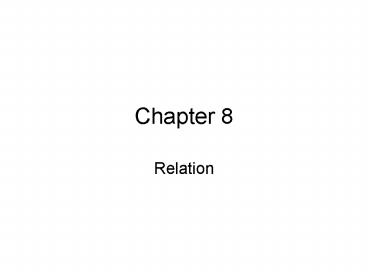Relation PowerPoint PPT Presentation
1 / 18
Title: Relation
1
Chapter 8
- Relation
2
Sec 8.1
- Relation and Their Properties
3
Definitions
- Binary Relation from A to B Let A and B be
sets. A binary relation from A to B is a subset
of A x B. - Notation Let set R be a relation. If (a,b)?? R
we write a R b. - Relation on a set A A relation on a set A is a
binary relation from A to A.
4
Reflexive, Symmetric, Transitive
- Reflexive A relation R on a set A is reflexive
if (a,a) ? R whenever a ? A. - Symmetric A relation R on a set A is symmetric
is (b,a) ? R whenever (a,b) ? R - Antisymmetric A relation R on a set A is
antisymmetric is (a,b) ? R and (b,a) ? R does not
occur except possibly when a b. - Transitive A relation R on a set A is called
transitive if whenever (a,b) ? R and (b,c) ? R
then (a,c) ? R.
5
Combining Relations
- R ? S
- R ? S
- R - S
- S - R
- S ? R Let R be a relation from A to B and let S
be a relation from B to C. The composite of R
and S is the relation consisting of ordered pairs
(a,c), where a ? A, c ? C, and there exists an
element b ? B such that (a,b) ? R and (b,c) ? S. - Rn If n 1, R1 R and if n gt 1, then Rn Rn-1
? R
6
Theorems
- The relation R on set A is transitive if and only
if Rn ? R for n 1, 2, 3,
7
Homework
- Sec 8.1
- pg. 527 2, 3, 4, 5, 7, 8
8
Sec 8.3
- Representing Relations
9
Representations using Matrices
- For any Relation R let MR mij where mij 1
if (ai,bj) ? R, and mij 0 if (ai,bj) ? R - Reinterpreting Properties
- Reflexive mii 1 for all I
- Symmetric If mij 1 then mji 1
- Antisymmetric If mij 1 then mji 0
- Transitive MR2 ( MR2) ? MR
10
Representation using Digraphs
- A directed graph, or digraph (V,E), consists of a
set V of vertices together with a set E of
ordered pairs of elements of V called edges (or
arcs). The vertex a is called the initial vertex
of the edge (a,b), and the vertex b is called the
terminal vertex of this edge. - Loop an edge of the form (a,a)
11
Relation Properties
- Reflexive Ever vertex has a loop
- Symmetric Every arc in the graph has an arc
with reversed initial and terminal endpoints - Antisymmetric No arc in the graph has an arc
with reversed initial and terminal endpoints - Transitive For any two arcs in the graph there
is a third arc which completes the cycle (A cycle
is set of arcs that start and end at the same
point)
12
Homework
- Sec 8.3
- pg. 542 1, 3, 4abc, 15, 23, 24, 25, 26, 27,
31(except irreflexive)
13
Sec 8.5
- Equivalence Relations
14
Definitions
- Equivalence Relation A relation on a set A is
called an equivalence relation if it is
reflexive, symmetric, and transitive. - Equivalent Two elements a and b that are
related by an equivalence relation are called
equivalent. The notation a?? b is used to denote
that a and b are equivalent elements with respect
of a particular equivalence relation.
15
Definitions
- Equivalence Classes Let R be an equivalence
relation on a set A. The set of all elements
that are related to an element a of A is called
the equivalence class of a. The equivalence
class of a with respect to R is denoted by aR
or just a (when only one relation is under
consideration)
16
Results
- Theorem Let R be an equivalence relation on a
set A. The following statements are equivalent - a ? b
- a b
- a ? b ?? ?
- In particular a ? b if and only if a b
anda ?is not equivalent to b iff a ? b ?.
17
Results
- Theorem Let R be an equivalence relation on a
set A. Then the equivalence classes of R form a
partition of S. - Conversely, given any partition of S, there is
an equivalence relation R that has the sets Ai, i
? I as its equivalence classes.
18
Homework
- Sec 8.5
- pg. 562 1, 2, 3, 7, 9, 13, 21, 26, 41, 47
- End Chapter 8

